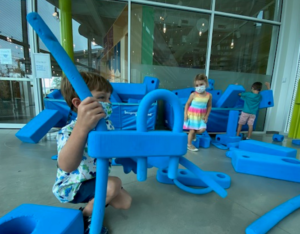In response to Hurricane Ida and school closures, the Museum spearheaded an effort to offer a minicamp designed with fun academic activities for the kiddos who were normally in schools at this time. We considered integrating provocations to see if the students wanted to talk about safety and their own storm stories. Provocations are materials used to provoke or expand on interests, thoughts, discussions, questions, creativity, and ideas.
We chose to read Over in the Wetlands: A Hurricane on the Bayou Story by Caroline Starr Rose and Rob Dunlavey, a beautifully illustrated tale written in verse about how the local wetlands animals take shelter when a storm approaches. During and after the reading, we made connections and asked the campers if they wanted to share their storm stories. Some of them shared that they felt more like they were on vacation as they visited Nana or played on the beach or watched movies. One child mentioned that she wanted to donate to people who had lost so much. Then, quite instantly, they all wanted to play or draw or wiggle.
One hour before dismissal on the last day of camp, a group of four and five-year-old campers played with the Imagination Playground big blue blocks. They asked us to be careful as we almost stepped on the spider that was protecting the castle. The castle was an impressive group effort. We noticed that Preston was concentrating on his own design, and we asked him to tell us about it.

“This is a generator in case the electricity in the house goes out. This is where the gas goes in.” He then added it to the castle.

One child was building an alarm for the castle in case the bad guys came in, equipped with a camera and a loud horn. A few minutes later, Alice described that she had built a chainsaw. We continued to listen to their storm vocabulary. We had just experienced a window into what’s on their minds, evidence that they are always listening and also that their parents had explained a lot to them over the past few weeks.
Their stories eventually evolved into magical powers and other imaginative play. We packed up shortly after that. As we were walking down the stairs to leave, Preston asked about how long hurricanes last. We explained how hurricanes lose power once they are over land. Another child chimed in that they can last for days and days. Preston then told me that Katrina was a 5 and Ida was a 4. We started a conversation about levees that lasted until we exited the Museum door, greeted by gusts of wind from Tropical Storm Nicholas.
We shared this experience with our staff on the following Friday morning. We asked: What do you hear? What is their thinking? What’s on their minds? We agreed on themes of protection. A castle is not just any structure, and an enormous spider was guarding it in addition to the alarm system. We also discussed the themes of problem solving and collaboration and noted that the children had agency in this make-believe world.
The staff then began to share stories of what they had been observing in the exhibits. One gallery assistant shared how a drawing prompted a discussion on molecules. A child asked, “What is air made of?” An education director commented on the empathy that she witnessed from a child in our Dig into Nature exhibit. We encouraged their pedagogy of listening, the practices of learning the skills and rewards of listening. Listening to children’s explanations and theories enhances the possibility of discovering how they think and how they both question and develop a relationship with reality. We encouraged our staff to listen and to ask open-ended questions.
We will continue to learn from documentation, as a process and as a tool, to observe and share what we understand about children’s problem solving and thought processes. We will continue to make children’s thinking and learning visible. This work will guide how we facilitate exhibits and meaningfully interact with children and families.
